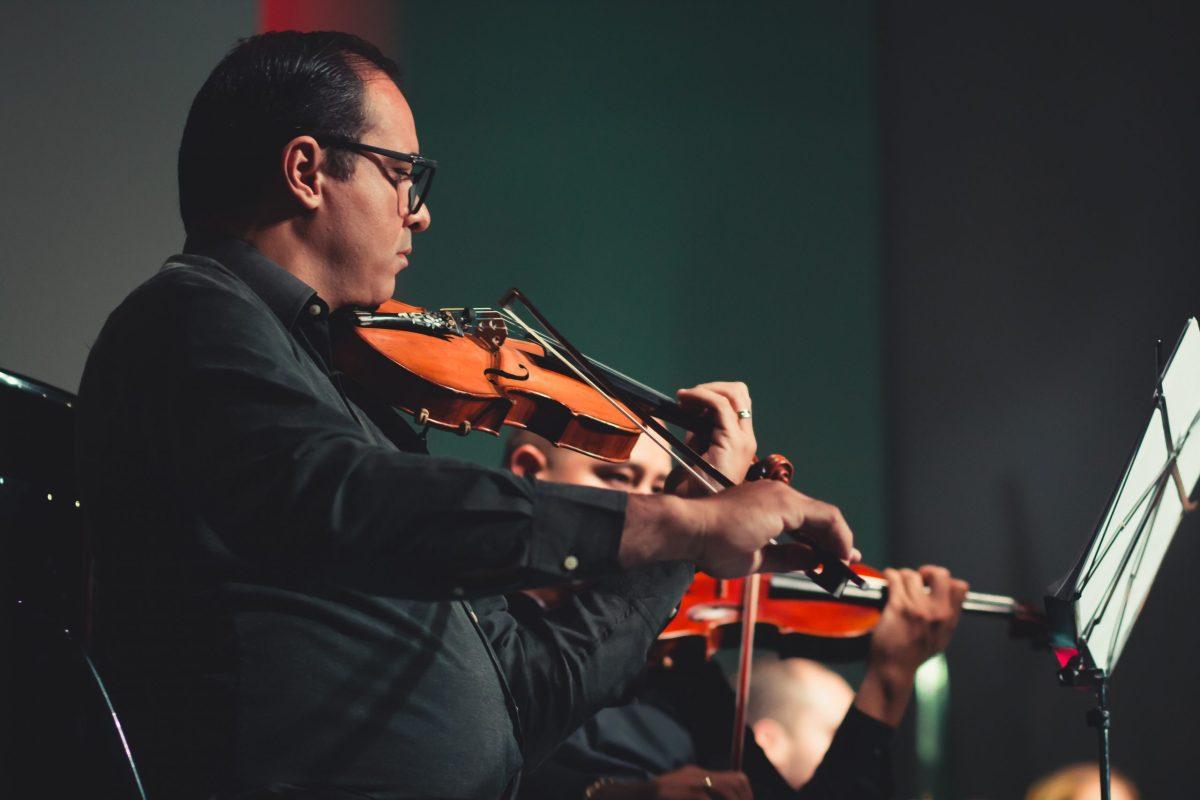The second movement begins with solo oboe. In the space of a held breath, she leads the audience into the song, through plucked pizzicatos and quick lifts, until the strings sweep the melody away into the tense grandeur of Tchaikovsky’s Fourth Symphony.
In the classical music community, it’s well known that Tchaikovsky wrote his Fourth Symphony in the grips of a deep depression, but emerged with a masterpiece. The Des Moines Symphony performed the piece at its masterworks concert in October, and the performers found parallels between its making and their own experience.
Like Tchaikovsky, many musicians found their depression, symbolic or literal, lifting as music and people once again filled concert halls that stood empty for the past year and a half.
The music of mental health
For assistant principal hornist Guinevere Wallace, the Des Moines Symphony’s October concert was her first with an audience since the pandemic started. Through quarantine, she’d discovered a new, meditative way of playing, and it changed her relationship with music and mental health.
“It was like a spiritual experience,” Wallace said. “Meditating and just being really quiet in my mind and listening to the nothing — the air. Music can be all-consuming and also undefined. It’s not words, it’s not direction — it can be whatever you want it to be in that moment.”
The connections between music and mental health are being explored by the Global Council on Brain Health, which convened a group of experts in February 2020 to examine the impact of music on the brain. Their findings are summarized in “Music On Our Minds: The Rich Potential of Music to Promote Brain Health and Mental Wellbeing.”
According to the report, people have never had so many ways to listen to music in “splendid isolation.” Gathering in a public space for a concert has been replaced with ear buds, smartphones and Bluetooth. However, the experts agree that something powerful emerges when music is shared as a group experience.
When people perform together, it activates brain circuits that affect empathy, trust and cooperation. It’s been proven to encourage a sense of calm, fight depression and stimulate social bonding. Most importantly, it creates a sense of belonging and place, feelings the pandemic has displaced for many people. However, as Wallace experienced, these feelings are vital for mental health.
“I know the people who are sitting around me — the horn section, the brass, everybody,” Wallace said. “They’re friends, people that I love, and it is incredibly special to get to be back with them and make music.”
A silent year
The world went quiet in March 2020, and concerts that had been months in the making were canceled overnight. Professional musicians lost out on income, and students on experience. An enormous void of instruments and relationships gathering dust yawned before them.
Nornubari Kaka, bassoonist for the Drake Symphony Orchestra and Drake Symphonic Band, lost not one, but two concerts that spring.
“We spent so many weeks and months preparing,” Kaka said. “It was really upsetting for all of us. And then the rest of the semester was just nothing. It felt very heartbreaking. It’s like, is all that work wasted?”
Unfortunately, her ensembles never revisited the pieces they’d spent so long on. However, they did resume concerts in the fall semester, delivered to a live-streamed audience with crackling audio and 720 pixels.
“It felt weird, to be honest,” Kaka said. “Without the audience, we didn’t get the feedback of ‘Wow, there are people actually listening,’ or the applause after each piece.”
Wallace compared playing for a live-streamed audience to recording a piece. “I have to work a lot harder to stay engaged,” she said.
The low quality of the livestreams and lack of audience deadened the communal benefits of performance. Not only was the audience one step removed, but the resonance and emotion of a piece was lost. Applause was replaced with uncomfortable silence, and concerts became disappointing and disheartening.
Hearing the ring
As audiences returned to concert halls, many musicians found their playing changed. Losing a year and a half of live performances transformed Wallace and Kaka’s approach to playing music, bringing it to a healing and hopeful place.
“COVID changed my perspective on performing,” Wallace said. “Playing music has become so much more prayerful and meditative and being fully engaged in the moment. I love the physical aspect of it — the breathing. I mean, that’s life. That and then the all-consuming mental, ineffable ‘saying something with music.’ ”
The silence of the past year and a half stole the group experience of music, forcing the world into a less-than-splendid isolation. Musicians everywhere lost the special feeling of belonging that the Global Council on Brain Health considers so essential to mental health. Fortunately, there’s a lot to look forward to in the coming days.
“I’m excited to hear the music ring again,” Kaka said. “When you’re in person, you can feel the music within your body, the vibrations going through you. You can feel and see the passion of the musicians, and I think that’s a great thing people should witness.”
Visit dsmsymphony.org or drake.edu/music to return to the concert hall and feel the social and mental benefits of a live musical performance.
Update, Dec. 8: A previous version of this article misidentified Guinevere Wallace as Guinevere McIntyre.







